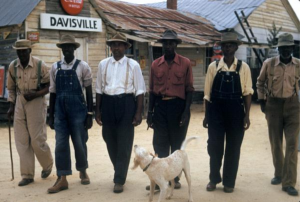Tuskegee syphilis experiment
 Participants in the Tuskegee Syphilis Study | |
| Date | 1932 - 1972 |
|---|---|
| Interest of | Susan Mokotoff Reverby |
| Description | A murderous experiment which looked at the progression of syphilis. Subjects were told that they were being treated, while in fact treatment was denied them. Exposed after 40 years by a whistleblower who went to the press. |
| Planners | U.S. Public Health Service, Centers for Disease Control and Prevention |
The Tuskegee syphilis experiment was a piece of medical research carried out on US citizens by the U.S. Public Health Service and the CDC. Like the Guatemala syphilis experiment, it exposed people to syphilis without their consent and withheld treatment.[1] It was terminated when Peter Buxtun, a whistleblower, went to the commercially-controlled media with details of the study.
Official narrative
The Tuskegee syphilis experiment initially involved 600 black men – 399 with syphilis, 201 who did not have the disease. The Centers for Disease Control stated that the men were told they were being treated for "bad blood", a local term for various illnesses that include syphilis, anemia and fatigue.
The study was conducted without the benefit of patients' informed consent and studied the progression of the disease in the absence of the treatment (penicillin) needed to cure it. In exchange for taking part in the study, the men received free medical exams, free meals, and burial insurance.
History
The study was initially controlled by the U.S. Public Health Service. Although originally projected to last 6 months, it actually went on for 40 years, later being controlled by the Centers for Disease Control and Prevention.
Exposure
Mindful perhaps of the WHO's 1964 Declaration of Helsinki, in 1966 Peter Buxtun, a PHS venereal-disease investigator sent a letter to the national director of the Division of Venereal Diseases to express his concerns about the ethics and morality of the experiment. The CDC reaffirmed the need to continue the study until completion; i.e., until all subjects had died and been autopsied. The CDC gained support for this position from local chapters of the National Medical Association (representing African-American physicians) and the American Medical Association (AMA).
Frustrated, Buxtun went to the press. The story broke first in the Washington Star on July 25, 1972 and became front-page news in the New York Times the following day.
Legal Action
A class action lawsuit was filed in 1972 by the victims and their families and a $10 Million out of court settlement was reached in 1974.[2]
Public Apology
After actions of Benjamin Payton, US President Bill Clinton publicly apologized on behalf of the federal government to the handful of study survivors in April 1997.[3]
References
- ↑ https://www.globalresearch.ca/take-these-masks-off-my-child/5745462
- ↑ http://www.csmonitor.com/World/Americas/2013/0614/Guatemalan-syphilis-victims-lose-hope-in-legal-battle-against-US
- ↑ http://www.socialworker.com/feature-articles/ethics-articles/The_Tuskegee_Syphilis_Study_and_Its_Implications_for_the_21st_Century/